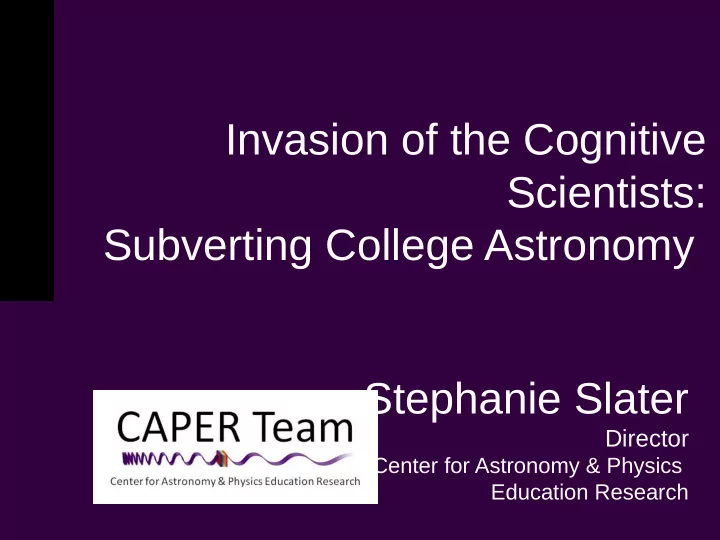

Invasion of the Cognitive Scientists: Subverting College Astronomy Stephanie Slater Director Center for Astronomy & Physics Education Research
Center for Astronomy & Physics Education Research • International, multi-institution Astronomy Education Research group • ~200 peer reviewed publications in AER
Center for Astronomy & Physics Education Research
Astronomy at the Post-Secondary Level • <200 majors/year, no typical major • Challenging confounding variables • 250,000 Astro 101 students • 40% of all pre-service teachers
…Intractable bits of content. A new misconceptions model: – Bad “data” • The facts you know that ain’t so. – Wayward “algorithms” • Phenomenological primitives – Dysfunctional “firmware” • Cognitive load, spatial reasoning/thinking/skills/ability – Unwilling “hardware”
Empirically establishing spatial thinking as the learning barrier.
Even with the tough stuff… Not much difference. Data Analysis and Inquiry in Astronomy Open inquiry through faded scaffolding The younger they are, the better they perform
“Easy Content”: 28 Hawaiian Phases of the Moon.
28 Hawaiian Phases of the Moon.
Getting a 2 year old’s attention. E ‘ohi‘ohi i na pono! HE KA HE IWI HE MAKAU HE LUPE Ua lako ka ipu a ka ho`okele. Maika`i!
Wayfinding for 2 year olds. Gather the needed tools! The Bailer The Backbone The Fishhook The Kite The navigator is provisioned. Well done!
Prediction of Celestial Movement I: Here we see Kamailemua (Acentauri) rising in Na Leo Malanai. (Pointing Southeast) Where will it set? S: Na Leo Kona! (Pointing Southwest) I: Maika’i.
General Content Quantitative Approaches Eva Kikas (2006) • – Spatial ability > verbal ability for factual/scientific knowledge • Slater, Heyer, Slater (2012) Vandenberg Rotation Paper Folding TOAST pre .40 ** .36 ** TOAST post .48 ** .37 ** TOAST <g> .26 ** .17 n.s. WDYK pre .31 ** .19 * WDYK post .43 ** .36 ** WDYK <g> .13 n.s. .18 *
Explanatory thinking Darrel Rudmann (2002) – Manipulatives improved scores – Causal model shift with S.R. score – S.R. trumps causal model Model Cube Comparison AstroGeo Scientific: Fixed Tilt x= 31 x= 19.5 Synthetic: Wobbly Tilt x= 12.8 x= 9.8 Naïve: Elliptic Orbit x= 9.2 x= 8.5
Slater (2007): Effective “Spatial Instruction” Pre- Mean Post- Mean % Norm. % Score % Score Change Gain Astronomical 39.05 62.38 +23.33* 34% Geography Rotation related 54.32 74.59 +20.27* 46% events Orbit and tilt related 27.24 77.44 +50.20* 69% events
Whole group Pre- Mean Post- Mean % Norm. % Score % Score Change Gain Astronomical 39.05 62.38 +23.33* 34% Geography Rotation related 54.32 74.59 +20.27* 46% events Orbit and tilt related 27.24 77.44 +50.20* 69% events Pre- Mean Post- Mean % Norm. “At-risk” students % Score % Score Change Gain Astronomical 43.94 53.03 +9.09 11% Geography Rotation related 50.91 67.27 +16.36* 33% events Orbit and tilt related 27.08 65.97 +38.89* 54% events
Moving Forward Task-oriented instruments Direction on Spatial Thinking Instruments Mentoring
Invasion of the Cognitive Scientists: Changing College Astronomy Stephanie Slater Director Center for Astronomy & Physics Education Research
Recommend
More recommend